Dioxygenyl hexafluoroplatinate
| |||
| Names | |||
|---|---|---|---|
| IUPAC name
Dioxygenyl hexafluoroplatinate
| |||
| Other names
Dioxygenyl hexafluoroplatinate(V)
| |||
| Identifiers | |||
3D model (
JSmol ) |
|||
| |||
| |||
| Properties | |||
| F6O2Pt | |||
| Molar mass | 341.072 g·mol−1 | ||
Except where otherwise noted, data are given for materials in their standard state (at 25 °C [77 °F], 100 kPa).
| |||
Dioxygenyl hexafluoroplatinate is a
eV, led Neil Bartlett to correctly surmise that it might be able to oxidise xenon (first ionization potential 12.13 eV). This led to the discovery of xenon hexafluoroplatinate,[2] which proved that the noble gases
, previously thought to be inert, are able to form chemical compounds.
Preparation
Dioxygenyl hexafluoroplatinate can be synthesized from the elements by the action of a mixture of
platinum sponge. At 350 °C, platinum tetrafluoride is produced; above 400 °C, dioxygenyl hexafluoroplatinate is formed.[1]
- T = 350 °C: 2 OF
2 + Pt → PtF
4 + O
2
- T > 400 °C: 6 OF
2 + 2 Pt → 2 O
2PtF
6 + O
2
Bartlett demonstrated that it can be synthesized at room temperature by the reaction of oxygen gas with PtF
6.[1]
- O2 + PtF6 → O2PtF6
Structure
Dioxygenyl hexafluoroplatinate(V) has a
rhombohedral crystal structure at low temperatures, and a cubic structure at high temperatures,[3] isomorphous to potassium hexafluoroplatinate(V), KPtF
6. Its ionic lattice is indicated by its insolubility in carbon tetrafluoride. In its cubic form, the PtF−
6 octahedra are slightly compressed along the three-fold rotational axis, along which the long axis of the [O
2]+
cations also lies. Each O+
2 cation is surrounded by 12 fluorine atoms, 6 of which surround it in a puckered six-membered ring, and of the remaining 3 each belong to the two PtF−
6 octahedra lying along the long axis of the cation.[1]
6. Its ionic lattice is indicated by its insolubility in carbon tetrafluoride. In its cubic form, the PtF−
6 octahedra are slightly compressed along the three-fold rotational axis, along which the long axis of the [O
2]+
cations also lies. Each O+
2 cation is surrounded by 12 fluorine atoms, 6 of which surround it in a puckered six-membered ring, and of the remaining 3 each belong to the two PtF−
6 octahedra lying along the long axis of the cation.[1]
Reactions
Dioxygenyl hexafluoroplatinate(V) is a convenient route to prepare other platinum(V) compounds, such as potassium hexafluoroplatinate(V) via reaction with potassium fluoride in iodine pentafluoride (IF
5) solution[3] in which iodine heptafluoride is produced:
- 2 O
2PtF
6 + 2 KF + IF
5 → 2 KPtF
6 + 2 O
2 + IF
7
References
- ^ .
- .
- ^ ISBN 9780323148474.


